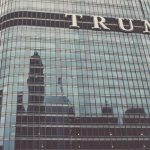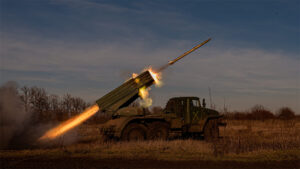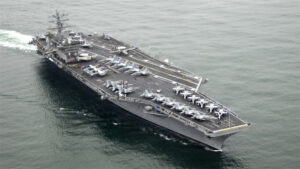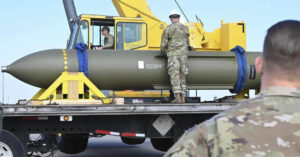In the late hours of September 30 a small bevy of leaks indicated Canada and the United States agreed to terms that will allow Canada to remain in the newest iteration of both countries’ premier trade relationship: the North American Free Trade Agreement. In the wee hours of October 1, said rumors were confirmed and fleshed out by both governments.
It has been a long road. Ronald Reagan initiated the process, George HW Bush finished the negotiations, Bill Clinton got the deal ratified, and George W Bush bridged the NAFTA relationship to North American security issues. Donald Trump has railed against NAFTA since the very beginning, and three decades later he made the abandonment and/or forcible renegotiation of every trade deal on the books a key piece of his presidential campaign.
The part of the American business community that depends upon international manufactures trade is hugely relieved – Canada and Mexico comprise about one-third of the total American trade portfolio. Simply walking away from NAFTA, as Trump often threatened, would have at a minimum triggered a Texas-centric American recession. Now businesses can look forward to revised rules-of-origin, agricultural access and dispute-resolution systems expressly modified to benefit American entities.
Overall changes to the trade pact are on the minor side: tweaks to dispute resolution mechanisms, increased requirements for local content in automobiles, improved access for digital firms both in the cloud and on the ground, minimum wage levels for some manufactured goods, greater access for U.S. agricultural products, and improved protection for intellectual property – particularly for pharmaceuticals. Overall, it’s a change in less than 5% of the original deal with most of the changes simply being updates to reflect the fact that it isn’t the 1980’s anymore.
Of course, this is not over. Completing the negotiations is a required step of critical importance, but now we get to deal with the fun and games of a trinational political ratification. In the United States, Trump will need to get the new NAFTA through the post-midterms Senate. In Mexico, outgoing President Enrique Peña Nieto will sign the deal on his last day in office, but it will be up to populist greenhorn Andres Manuel Lopez Obradorto get the text ratified and operationalized. Any number of things in either in-flux country and with either moody leader could still go horribly, terribly typical and wreck the whole thing.
But the most interesting developments might well be up in the Great White North.
First, the backstory of how Canada fits in to American-led trade deals.
The core of the American grand strategy during the Cold war was very butter-for-guns. The Americans would create a global Order to indirectly subsidize everyone’s economies, and in exchange the allies would grant the Americans broad control of their security policies so the Americans could fight the Cold War without having to refer everything to committee. That’s the core tenant of the American relationship with everyone from London to Paris to Berlin to Rome to Tokyo to Seoul to Canberra (and even Beijing).
But not for Ottawa.
That’s because the Canadian educational system is sufficiently strong that Canadians can read a map. They know that no matter what the Americans do to defend themselves, there is no version of American security so limp that it does not also require the defense of Canada. Add in a cultural, economic and political understanding of Americans matched by no one else on Earth, and throughout the Cold War and post-Cold War periods Ottawa has always been able to turn an inch into a yard when dealing with Washington. Perhaps the most obvious example of this is Chapter 19 of the NAFTA accords which established tribunals for arbitrating trade disputes between American and Canadian firms. This chapter was negotiated by Reagan – hardly a president noted for the willy-nilly waiving away of American sovereignty or autonomy.

Ok, with that set up, let’s now dive into the Game-of-Thrones-with-a-Smile-
There are three types of democratic political systems. The first is unitary where the capital city is large and in charge: France, the Netherlands, Argentina, Japan, Korea, New Zealand, Sweden. The second is federal. The powers of governance are balanced among local, regional and national authorities: the United States, Germany, Australia, Mexico, India.
The third is confederal: where the provinces have far more power than the national authorities on most issues. Confederal systems are of sort messed up because on most issues the individual provinces hold veto power over most issues. In confederal systems, change comes veeeeeeeeeeeeeeeeeeeery slooooooooooooooowly: Switzerland (which only granted women the vote at the national level in 1991) and Canada (which only signed a comprehensive internal free trade agreement in 2017).
That’s strange even before you mate it to the Canadian ethnic divide.
Way back when, both Canada and the United States used to be British colonial possessions. But other European powers held North American colonies as well, and in 1754 British-French tensions boiled up into a decade long conflict we know as the French and Indian War. In that conflict the French were roundly defeated by a combined force of British Redcoats, Canadian colonists, the Iroquois Confederation and Yankee Doodles led by one George Washington.
The terms of the post-war settlement handed control over several French possessions – what we know today as Quebec – to the British. Because the British decided they didn’t want to kill the French who were already there or fight a war of occupation, they granted the French colonials broad economic, cultural and linguistic autonomy: the Quebecois were born. About a century later when the British started incrementally granting their Canadian colonies independence, Quebec was tossed in with the Anglo provinces – British-granted autonomy and all.
Bam! Canada is a bi-lingual, bi-national confederation.
One of many outcomes of this is the Quebecois have the ability to veto all kinds of things at the national level. It also means that what seem to be irrelevant, even petty, topics at the provincial level tend to shape Canada’s national and even international policies. Policies like trade. For example, Quebec maintains one of the most inefficient, coddled, expensive, low-quality dairy industries in the world – and Quebec’s ability to shape national policy has enabled it to shape trade policy with the United States to protect Quebecois dairy.
The new NAFTA text takes direct aim at that industry, hardwiring in a tripling of U.S. dairy access to the Canadian market as well as changing protein standards for dairy products, a technical tweak highly likely to increase American access even further. Quebecois farmers are, unshockingly, apoplectic and are threatening political consequences.
It isn’t an empty threat.
Canada’s Liberal Party thinks of itself as the “natural” ruling party of Canada. It is in some serious trouble. Let’s start with its leader.
Prime Minister Justin Trudeau still may be a cool-sock-wearing liberal heartthrob on the global stage, but the shine has most certainly come off back at home. No one ever thought Trudeau was very bright. A cadre of liberal technocrats maneuvered him into power largely to ride the name recognition. I don’t mean this as a condemnation. The technocrats are doing a better job than their equivalents in most other Western countries, and if in a confederal system all you need a prime minister for is to kiss some babies, flash some smiles and cut some ribbons, the younger Trudeau is a fine choice. But his lack of foresight, political skills and leadership has costs, and technocratic cabinets aren’t that great in times of extreme change.
Consider a person for whom I hold immense respect: Chrystia Freeland. She took over Canada’s foreign ministry ten days before Donald Trump became the U.S. president. She inherited the old Canadian foreign policy rulebook that detailed how to best exploit Canada’s position as a free-rider in the American-led global Order. She quickly discovered Donald Trump was not only serious about ending the Order and re-negotiating NAFTA, but that the American president thinks of Canada as a normal country that warrants no exceptions whatsoever on economic and security policy.
Freeland has spent most of the past two years trying to protect the old arrangements, to no avail. Because Canada is confederal, her hands were tied. She couldn’t offer concessions. And because Trudeau is a (fantastically well-coiffed) bobble-head, there was no leadership from the top as to how to deal with such radically changed circumstances. When Trump initialed a bilateral deal back in September with Mexico to proceed with NAFTA2 withoutCanada, Freeland realized she had to take drastic action for the good of the country. The result? Last week Freeland dropped her hardline stance, caved a bit, and got the best deal she thought she could.
So now we have several things moving at the same time.
First, the Liberal party is getting gutted politically. Earlier this year the Liberals were ejected from power in Ontario, Canada’s most populous province. On October 2 the Liberals of Quebec – the second-largest province – weren’t simply defeated, but gutted by Coalition Avenir Québec (Coalition for the Future of Quebec), a center-right party so new as to be wet behind the ears. In May 2019 Trudeau’s semi-ideological allies in Alberta, Canada’s richest province, are likely to be eradicated by a conservative/separatist alliance. It would be challenging for a strong leader to turn these sorts of defeats around for national elections in 2020. Justin Trudeau is not such a leader.
Second, Trudeau faces a more personal challenge. He is Quebecois ethnically, but he was raised in Ottawa. English is his first language. His French is comme ci comme ça. The Quebecois like having one of “their own” in charge, but only if he can deliver. The new NAFTA’s dairy rule combined with the fresh winds in provincial rulership have just denied him what gravitas he held in his “home” province.
Third, the Americans will not let up. Trump’s negotiating team – lead by one very wiley Robert Lighthizer – refused to lift America’s aluminum and steel tariffs in the rubric of the NAFTA re-negotiation. And they won’t until such time as the Canadians ratify the new treaty text.
Fourth, don’t forget Foreign Minister Freeland. Her personality is the work of the same character artisans which brought us Hillary Clinton and John Bolton. Professional, direct, competent, a bit schemy, and if you cross her she will cut you. But she’s still Canadian so most people think of her as mostly nice most of the time.
Freeland has just been forced by circumstance to take a strong leadership role and execute some seriously decisive actions – something her boss is broadly incapable of. If she wasn’t already thinking that perhaps her party needs a new leader and her country a new prime minister, she probably is now. And since she clawed her way from opposition backbencher to foreign minister in less than fifteen months, I’m going to go out on a limb and guess she has an idea of who might be right for the job.








